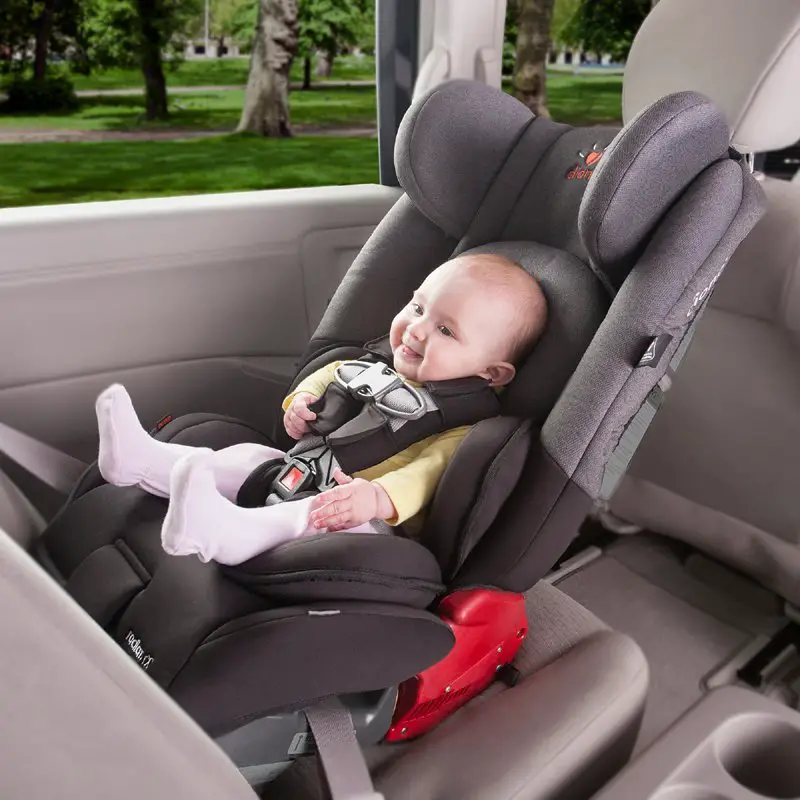The Dreaded Motion Sickness Won’t It Help To Turn Around My Child
The long and short: most kids do not puke less when forward-facing compared to rear-facing.
Weve got lots of information on motion-sickness over here including an explanation of why it is believed to occur, things you can do to decrease the chance of your kid puking, and how to minimize the mess and clean up if your kid does puke.
What Is The Height And Weight Limit On A Car Seat
California Law. Current California Law: Children under 2 years of age shall ride in a rear-facing car seat unless the child weighs 40 or more pounds OR is 40 or more inches tall. The child shall be secured in a manner that complies with the height and weight limits specified by the manufacturer of the car seat.
When Should A Child Face The Front Of The Car Seat
Forget about age when it comes to determining when to turn your childs car seat to face the front of the car. As of 2018, the American Academy of Pediatrics recommends children remain in a rear-facing car safety seat as long as possible, until they reach the highest weight or height allowed by their seat
Recommended Reading: Fl Lost Title
Myself And Others Will Be
Yes, a car seat is another thing to schlep with you on the endless trek through the airport. What do we use to keep the car straight or make it turn? When to turn around baby’s car seat. This link is to an external site that may or may not meet accessibility guidelines.
If your car doesn’t have a control to adjust the seat height, sit on a cushion to help keep your hips level with your knees.
A convertible car seatalso referred to as a toddler seatis designed to face either backward or forward in the car.
Time To Move To The Next Type Of Car Seat

Also Check: How To Keep Squirrels Away From Your Car
Why Do Many Parents Move To Forward
Whats behind North American parents big rush to switch to forward-facing as soon as theyre legally allowed? In Canada, Crossfield estimates that about 50% of parents turn their kids forward-facing even before age two. But why?
For Canadian parents, one reason may be that many follow the guidelines set out by provincial and federal governments, and medical organizationswhich, says Crossfield, are woefully outdated. For example, the Canadian Paediatric Societys position on this issue is that rear-facing car seats should be used until children weigh at least 10 kg , and are at least one year of age and able to walk. Similarly, the Transport Canada website states that children who have outgrown their rear-facing seat and weigh at least 10 kg may ride facing the front in a child car seat. Crossfield notes that, in rare cases, this could mean a four-month-old baby could be legally facing forward.
Another reason parents are turning their kids too soon is because they lack a solid understanding of how collisions work. Their biggest fear is their kids legs breaking, says Crossfield. But they might not realize that the alternative is a broken spine or head injury.
Consequences Of The Violation
- Troopers began issuing warnings for violations of the booster seat provision of the Child Passenger Safety Act on July 1, 2006.
- Troopers began issuing citations for violations of the booster seat provision of the Child Passenger Safety Act on July 1, 2007.
- The $60 fine will be waived if proof is provided to the court that an appropriate child safety seat has been acquired. Court costs still apply.
Read Also: Avis Owns Budget
How Do I Use A Booster Seat
- A booster seat positions your child so that the seat belt fits across the strong bones of the hips and pelvis and not the abdomen, to protect your child from injury.
- While seated in the booster seat, the lap belt should fit low and snug across your childs hips, and not up on their belly.
- The shoulder portion of the seat belt should be positioned over the chest and collarbone, staying between your childs neck and shoulder so that it does not touch the neck.
- Follow the directions for the booster seat to know how to route the seat belt under any armrests or through any belt guides, as directed.
How Much Safer Is Rear Facing Than Forward Facing
Car seat research has shown that children up to 23 months old are about 75 percent less likely to die or sustain serious injury in a rear-facing car seat than a forward-facing one. Thats because a rear-facing seat spreads the crash force more evenly across the back of the car seat and the childs body.
Also Check: How To Make Car Freshies
Why Is A Rear
To understand why children should stay in a rear-facing seat as long as possible, parents first need to know what happens in an accident. If a car crashes at about 30 mpha relatively low speedit can throw a 10 pound child with the force of about 450 pounds of momentum, says Dr. Hoffman, who is also a certified child passenger safety technician instructor. For comparison, he notes that’s about 40 percent more momentum than if you were to drop a 10 pound bowling ball out of a third story window.
“All of that force has to go someplace, and we have to make sure that force is dealt with in a way that will protect the person,” he says. “One of the most important ways that car seats help protect kids is that they spread that force over the widest amount of area possible If you think about what happens in a rear-facing seat in a crash, the child is pushed into the seat and the entire force of the crash is spread head to toe.”
In a front-facing car seat, the amount of protective surface areaa five-point harness, in that caseis a lot smaller. And it doesn’t protect a baby’s “enormous wiggly-woggly head” as well as a rear-facing seat would.
How Long Should My Child Remain In A Forward
Once your child has graduated to a forward-facing car seat, its recommended they remain in it until they reach the height and weight limit of their seat. This can be quite some time as forward-facing car seats can hold anywhere from 60 to 100 pounds depending on the model!
Its important to also keep in mind that even after your child has outgrown their forward-facing car seat, they should still use a booster seat to ensure your cars seat belt system fits them properly.
Children arent ready to use the seatbelt alone until theyre around
Also Check: How To Make Car Freshies
My 20 Month Old Is Too Big For Rear
Imagine its November and your 20-month-old has outgrown all of their winter clothes from last year. Would you not buy them new winter clothes because it will be warmer in four months? Of course you would buy them the clothes! The same should go for the car seat!
The car seat is one of the only products you will ever buy for your child that has the potential to save their life! Just like your child needs new clothes frequently, they may need a new car seat sooner than you thought. If you are in a crash, you will be relieved knowing that you gave them the best protection possible.
Is It Safe To Put A Carseat In The Middle

Where is the safest place to put a car seat? A study published in Pediatrics, showed for children newborn to 3 years old and all installs being equal, sitting in the center rear seat is 43% safer than sitting on the side in the back. The rear center position will be the furthest from any impact in any type of crash.
Don’t Miss: Carvana Lease Car
What Are The Car Seat Rules For Rear
You want your child to be happy, comfortable and safe when you travel in the car. We explain everything you need to know about the rear-facing car seat law and forward-facing car seat law so you’ll get it right.
Forward-facing car seat age
Many parents want to know the right age for a forward-facing car seat, but this is not as straightforward as it may seem. Legally, your child can travel in an ECE R44/04 approved car seat facing forward once they are 9 kg, which is approximately age nine months. But don’t be tempted to rush into making the switch. There are lots of good reasons why many parents choose to increase the age before facing their baby forward in a car seat.
Why is rearward-facing travel safest for babies and young children?
Children travelling forward-facing can be thrown forwards in a head-on collision. That puts stress on the fragile head and neck, which can lead to serious injury.
If your child is travelling rear-facing, the car seat spreads the forces across the whole back, protecting the delicate head and neck. As 70% of accidents are frontal collisions, it’s safest for children to travel rearward-facing until their muscles and bones have properly developed.
What is the i-Size rear-facing car seat law?
i-Size car seats meet the highest level safety standards. If you have chosen an i-Size car seat, your child must travel facing the rear until they are 15 months old by law.
Car Crash Physics: Why Rear
Luckily, around 60-80% of all car crashes are rear-end collisions. In a rear-end collision, your child is in the back seat and you are hopefully both harnessed in by the car seat and seat belt.
When a collision happens in the front of a car, you are your child are forced forward. With a five-point harness system, your childs neck and spine will remain where it should be. When they are facing backward, the impact of the crash is far less severe than if a child is facing forward.
When a child whos spine and limbs havent fully developed is in a car crash, if they are forward-facing, all of the force from the crash can severely injure the child.
While it can be tempting to turn your baby around sooner because of an older sibling or an older relatives outdated recommendation, think about your childs safety. Is it worth it to turn them around if they arent properly protected in a car crash?
Recommended Reading: How To Repair Cigarette Burns In Car Upholstery
When To Switch To A Front Facing Car Seat
Many parents look forward to switching their child forward-facing, but this definitely isnt something you should rush. Children are much safer rear facing, so its important to keep them in that position for as long as possible.
You should only switch to forward facing if your child exceeds the weight and height limits of their car seat. This is generally met after they are 2 years old.
Children weighing more than 22-35 pounds in a rear-facing only seat may have outgrown that seat. It might be a good idea to consider another rear-facing style seat, especially if they are younger than 2.
Children weighing 35-40 pounds in convertible seats and 40-50 pounds in 3-in-1 seats may be ready to make the switch.
Children with less than 2 inches of clearance above their head rear-facing may be ready for switching forward. Rear-facing only car seats usually work with babies up to 36 inches tall.
Larger car seats can seat children up to 40 inches rear-facing. Checking your car seats specifications for height is the safest way to determine when its time to make the switch.
Switch to a Front Facing Car Seat if your child:
- Meets the specified weight limit for rear-facing with your car seat
- Exceeds height specifications for rear-facing with your car seat
- Has a height that allows their head to reach within 2 inches of the top of the seat
Does A 7 Year Old Need A Car Seat
According to the manufacturers recommendations, children 0 through 3 years old and those taller less than 40 inches need child safety restraint. As of 2009, car seats and booster seats should be installed for children as young as 4 and as old as 75 pounds and less than 57 inches tall. Children of at least four years old must be riding a booster seat or adult seat belt with 80 pounds or 57 inches of height.
Also Check: Lease Through Carvana
What About Their Legs
Many parents express concern about the fact that their child seems cramped or that their legs must be folded before they have reached the maximum height or weight for their rear-facing seat.
Children can safely sit with their legs crossed, extended, or hanging over the sides of their rear-facing seat. Leg injuries for rear-facing children are very rare, according to the AAP.
When To Turn A Car Seat Around For Baby
According to the American Academy of Pediatrics, all children should ride in a rear-facing seat as long as possiblespecifically until they reach the highest weight or height allowed by their car seat model. “Most convertible seats have limits that will allow children to ride rear facing for 2 years or more,” says the organization. “When infants outgrow their rear-facingonly seat, a convertible seat installed rear facing is needed.”
Dr. Hoffman agrees with this recommendation. “Our advice is you stay rear facing as long as possible because of physics until the seat says you need to turn around,” he says. “There’s no reason given the seats we have on the market now a child should ever have to be forward-facing before their second birthday.” He adds: “The basic principle for everything is you delay transitions as long as possible.”
Recommended Reading: Replacing Car Title In Florida
When Can I Put My Babys Car Seat Forward Facing
The American Academy of Pediatrics recommends that children ride in a rear-facing seat until at least age two, or until they reach the highest weight limit allowed by their manufacturer and fit well within its dimensions.
Some parents may wonder when is the right time to switch from a rear-facing to forward-facing child restraint. The AAP recommends children be at least one year old and 20 pounds before they can ride forward-facing.
I Already Turned My Kid Forward

Yes! When we know better, we must do better. A few months ago when you turned her forward facing you did what you thought was best, but now you know differently. Avoid regrets, and give your child the best protection.
Many parents worry that it will be a disaster turning an older child back rear-facing. Here is one moms experience turning her almost-3-year-old son back rear-facing:
I was initially very hesitant to move my almost three year old son to rear facing from forward facing. He has been sitting forward facing for over a year and can be strong willed when it comes to change. However, after hearing how much safer it is I was willing to try. The first three or so drives were very difficult as he asked to look out mama and dadas window almost the entire time. We ignored and distracted and I was about to give up when I noticed that although he still complained about sitting rear facing it happened less and less. Now he asks maybe once every other drive if he can sit forward facing and was even fine the other day when his friend joined us and sat forward facing. It was a tough first few drives, but I am very happy we did it and I feel so much safer.
Also Check: Does Aaa Ship Cars
Your Guide To Car Seat Safety
Keeping your little one safe and sound in the car is a vital part of being a parent. From the first drive home from the hospital to all of the little league practices in between, you want to make sure your child is as safe as possible in the car.
The American Academy of Pediatrics has changed some of the car seat recommendations in recent years. Heres a round-up of everything you need to know about when to move your child from rear to front-facing along with some helpful car safety tips.